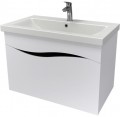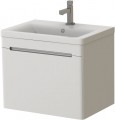Additional items and equipment included in the delivery kit in addition to the box/console itself, or provided in its design.
—
Washbasin. The washbasin shell itself is the object for which a pedestal/console is initially bought. The presence of this item in the kit not only relieves the owner of additional hassle on search and purchase - the standard sink is also optimally main function installation on the «native» design. On the other hand, the appearance and functionality of the complete washbasin may not correspond to the wishes of the user, so sometimes it is better to buy a cabinet and sink separately.
—
Shelves. In this case, additional shelves, dividing the interior of the cabinet into several tiers. This is convenient for placing a large number of comparatively small items (and in the cabinets for the washbasins usually keep these).
—
Open shelf. The presence in the design of the product of one or more shelves without doors or drawers, providing free access to the internal space. An open shelf creates a feeling of spaciousness, makes it easy to organize contents, and you can get the necessary items out of it without opening doors or pulling out drawers.
—
Handles. Handles for opening doors and drawers. This may include both external and concealed handles; the latter have the form of distinc
...tive notches on the ends of doors or boxes. However, such a notch is considered a handle only if it is supplemented by a metal insert.
In turn, the absence of handles in the set usually means that doors and boxes are equipped with either hollows without metal inserts, or the opening mechanism by pressing (push-to-open) or to open them directly behind the ends. Technically, another option is possible - handles need to buy separately; however, in practice, it is almost not found.
— Closers. Devices that make the closing of doors/boxes somewhat automated and more user-friendly and safe for the construction itself. The main function of the closer - «to pull» partially open or closed door to the extreme position and to keep it in this position, not allowing to accidentally open or close - from the draught, uneven installation of the cabinet, etc. In addition, On the final stretch of movement, the device can brake the door (even if it is pulled with force), preventing too much impact at the extreme position.
— Legs. Feet for installation on the floor, used in models with appropriate installation capabilities (see above). Compared to the whole base, the legs are less demanding to the quality of the floor; therefore, if the even surface in the bathroom has not worked out, on the floor it is recommended to use pedestal cabinets. On the other hand, the legs are less reliable than the solid base, and are more likely to break.
— Laundry basket. Basket for storing dirty clothes before washing. As a rule, it is built into the box itself, and the design of such a device can be different. So, in some models the basket looks like a grille attached to the hinge door, in others this function performs one of the drawers, and so on. N. However, in any case, the closed design prevents the spread of odors from non-stiran clothing. The exact size of the basket may vary; most often it is relatively small, but even such a device will be useful for storing underwear, socks and other small items.
— Bracket. The part for fixing the product to the wall - usually in the form of a «corner», one side of which is attached to the wall, and the other protrudes horizontally. Such parts can be completed in the main console (cf. «Type»). Because wall cabinets usually use other methods of attachment.The material from which most of the pedestal body is made — with the exception of the front part (facade), the material for it is indicated separately.
— Chipboard. Abbreviation for "chipboard". Inexpensive and at the same time quite practical material used in almost all price categories of cabinets for washbasins.
The case made of chipboard does not have such an attractive appearance and somewhat worse water resistance than MDF, however, it is cheaper, and the mentioned shortcomings are easily compensated for by using various impregnations and coatings (especially since the case is not as visible as the facade).
—
chipboard. For the production of chipboard, only high-quality chipboard with a laminated surface is used. Laminate acts both as a protection of wood from moisture, and as a decorative surface. The use of laminated chipboard at the base of the body makes the cabinet more affordable in comparison with MDF models, while it turns out to be just as beautiful and spectacular as premium models made from an array of natural materials. The main disadvantage of this material is the presence of formaldehyde resins in the composition of this material.
— MDF. A common name for medium density fibreboard (from the English label MDF). Such material has a more pleasant appearance than chipboard, it is also somewhat more reliable and moisture resistant, however, it is much more ex
...pensive. Therefore, even in expensive cabinets, solid MDF cases are extremely rare.
— Wood. At the heart of the cabinet is natural wood. The wooden case characterizes the high class of the model and the status of the product. This material is highly environmentally friendly and has excellent strength characteristics. The most commonly used woods are beech, larch and cork. A cabinet made of wood is often covered on top with a layer of clear varnish or laminated coating.
— Acrylic stone. Cabinets made of acrylic stone are not only visually attractive, but also reliable, durable, and also very practical. Acrylic stone is a synthetic polymer obtained from acrylic resins, aluminium hydroxide, bulk filler and coloring pigments. This material is often called artificial stone. Artificial acrylic imitates the surface of natural stone, while it is as strong, reliable and durable as natural stone. Artificial acrylic is absolutely environmentally friendly, it does not absorb moisture or odours. Among the shortcomings, only the high price can be noted, as well as the high weight, which requires the use of more reliable fasteners than in the case of chipboard / MDF.
